
The feathered thorn is a moth of the family Geometridae. It was first described by Carl Linnaeus in 1761.
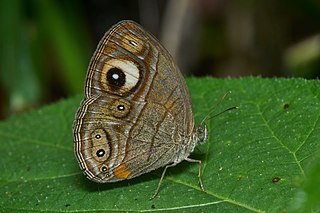
Mycalesis patnia, the glad-eye bushbrown, is a satyrid butterfly found in southern India and Sri Lanka.

Rothschild's birdwing is a large birdwing butterfly, endemic to the Arfak Mountains in Western New Guinea.
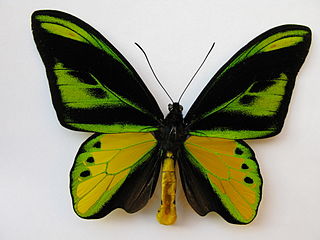
Ornithoptera chimaera, the chimaera birdwing, is a birdwing butterfly of the family Papilionidae. It is found in mountain areas of New Guinea, 1000 meters above sea level.

Ornithoptera paradisea, the paradise birdwing, is a species of birdwing butterfly found in New Guinea.

Eumorpha capronnieri is a moth of the family Sphingidae first described by Jean Baptiste Boisduval in 1875.
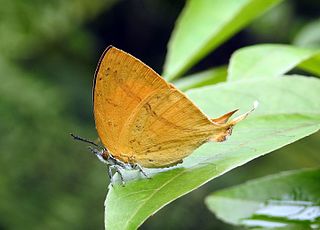
Loxura atymnus, the yamfly, is a species of lycaenid or blue butterfly found in Asia.
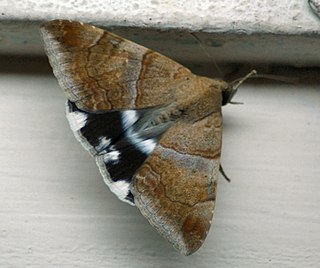
Achaea janata, the castor semi-looper or croton caterpillar, is an erebid moth, the caterpillars of which are termed 'semi-loopers' due to their mode of locomotion. It is found from the Indo-Australian tropics and subtropics, extending south to New Zealand and east through the Pacific archipelagoes to Easter Island. It is a major pest of castor throughout the world.
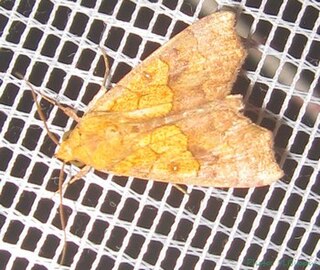
Anomis is a genus of moths in the family Erebidae.

Anomis flava, the cotton looper, tropical anomis or white-pupiled scallop moth, is a moth of the family Erebidae. The species was first described by Johan Christian Fabricius in 1775. It is found in large parts of the world, including China, Hawaii, São Tomé and Príncipe, the Society Islands, Thailand, New Zealand, and Australia. Subspecies Anomis flava fimbriago is found in North America.
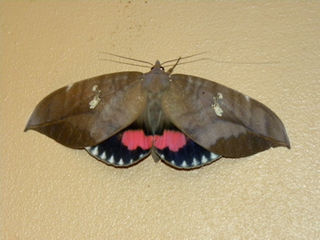
Phyllodes imperialis, the imperial fruit-sucking moth or pink underwing moth, is a noctuoid moth in the family Erebidae, subfamily Calpinae. It was first described by Herbert Druce in 1888. The species can be found in north-eastern Queensland to northern New South Wales, Papua New Guinea, Solomons, Vanuatu and New Caledonia.

Thyas coronata is a species of moth of the family Noctuidae first described by Johan Christian Fabricius in 1775. It is found from the Indo-Australian tropics of southern China, Taiwan, Japan, Nepal, India, Sri Lanka to Micronesia and the Society Islands.
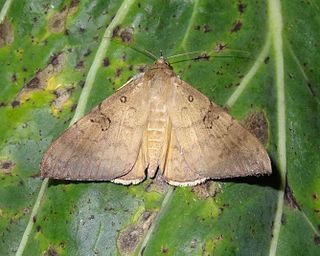
Oxyodes scrobiculata, the longan semi-looper or longan leaf-eating looper, is a moth of the family Erebidae. The common name "looper" is used despite looper moths generally being in the family Geometridae. The species was first described by Johan Christian Fabricius in 1775. It is found from the Indo-Australian tropics of India, Sri Lanka, Myanmar, China, east to Guam, Queensland, New Caledonia, Fiji, Samoa and Tonga.

Achaea serva is a species of noctuid moth of the family Erebidae first described by Johan Christian Fabricius in 1775. It is found from the Indo-Australian tropics of India, Sri Lanka, Myanmar, China, Borneo, Hong Kong, Java, the Philippines, the New Hebrides, to Okinawa, many western Micronesian islands and New Guinea and Australia.

Eudocima phalonia, the common fruit-piercing moth, is a fruit piercing moth of the family Erebidae. The species was first described by Carl Linnaeus in his 1763 Centuria Insectorum. It is found in large parts of the tropics, mainly in Asia, Africa and Australia but introduced into other areas such as Hawaii, New Zealand and the Society Islands. It is one of major fruit pests in the world.

Marumba spectabilis, the rosey swirled hawkmoth, is a moth of the family Sphingidae. The species was first described by Arthur Gardiner Butler in 1875.
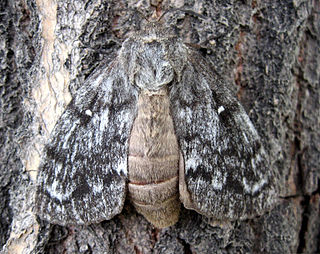
Dendrolimus superans, also called the white-lined silk moth, Sakhalin silk moth, Japanese hemlock caterpillar, Siberian silk moth, Siberian moth, Siberian conifer silk moth, Siberian lasiocampid or larch caterpillar, is a moth of the family Lasiocampidae.

Eurema sari, the chocolate grass yellow, is a butterfly in the family Pieridae. It is found in Southeast Asia.

Gadirtha fusca is a moth of the family Nolidae. It is found in east-central and south-eastern China.
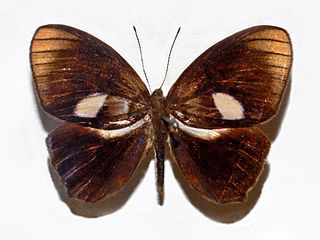
Paralaxita telesia, the common red harlequin, is a species in the butterfly family Riodinidae.























